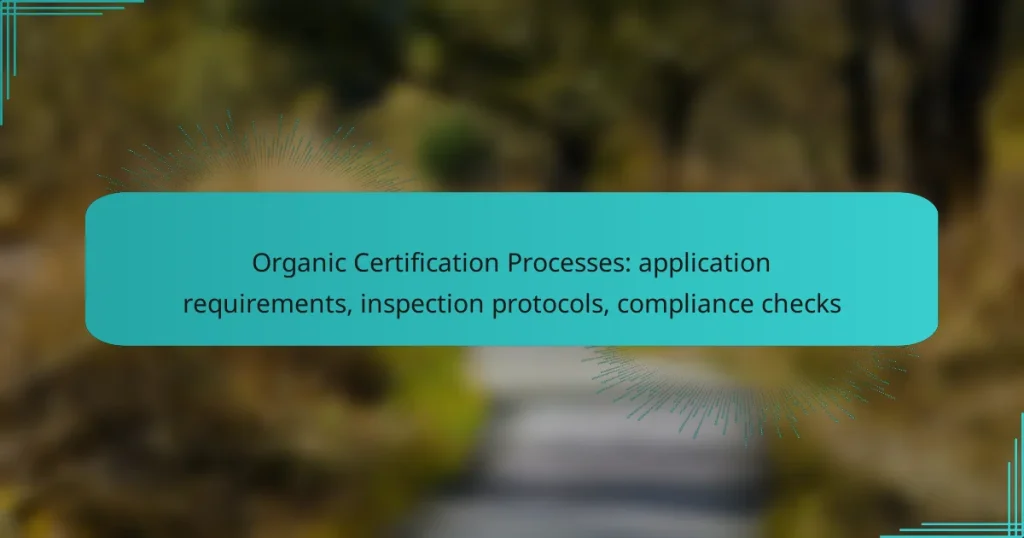Organic certification processes require applicants to meet specific standards and provide detailed documentation to demonstrate compliance with regulations. The inspection protocols include initial evaluations and annual follow-ups to ensure adherence to organic practices. Additionally, compliance checks systematically assess agricultural practices and records to confirm alignment with established organic standards.

What are the application requirements for organic certification in Australia?
To achieve organic certification in Australia, applicants must demonstrate adherence to specific organic practices and standards set by the Australian government. This involves providing comprehensive documentation and proof of compliance with regulations governing organic production.
Documented organic practices
Applicants must submit a detailed description of their organic practices, including cultivation methods, pest management strategies, and soil fertility programs. This documentation should clearly outline how these practices align with organic principles, such as sustainability and biodiversity.
It’s essential to maintain consistency in these practices over time, as any significant changes may require re-evaluation of the certification status. Regular updates to the documentation can help streamline the certification process.
Compliance with Australian standards
Compliance with the Australian Organic Standards is mandatory for certification. These standards dictate the requirements for organic production, processing, and labeling. Familiarity with these standards is crucial for ensuring that all practices meet the necessary criteria.
Applicants should regularly review the standards, as they may be updated. Engaging with a certifying body early in the process can provide guidance on compliance and help identify any potential issues before the application is submitted.
Proof of inputs and materials
Certification requires proof that all inputs and materials used in organic production are compliant with organic standards. This includes seeds, fertilizers, and pest control substances. Documentation such as invoices and supplier certifications should be collected and organized.
It’s advisable to source inputs from certified organic suppliers to simplify the verification process. Keeping a list of approved inputs can help ensure compliance and reduce the risk of using non-compliant materials.
Record-keeping procedures
Effective record-keeping is vital for organic certification. Producers must maintain accurate records of all operations, including planting dates, input usage, and harvest yields. These records should be easily accessible for review during inspections.
Implementing a systematic approach to record-keeping, such as using digital tools or spreadsheets, can enhance efficiency and accuracy. Regularly updating records will facilitate compliance checks and inspections.
Training and education requirements
Producers must ensure that all staff involved in organic practices are adequately trained in organic standards and procedures. This includes understanding the importance of maintaining organic integrity throughout the production process.
Participating in workshops or training programs can enhance knowledge and skills related to organic farming. Documenting training sessions and certifications can also support the certification application process.

What are the inspection protocols for organic certification?
The inspection protocols for organic certification involve a systematic evaluation of agricultural practices to ensure compliance with organic standards. These protocols include initial inspections, annual follow-ups, and specific criteria that must be met to maintain certification.
Initial inspection process
The initial inspection process is crucial for determining whether a farm or facility meets organic standards. Inspectors evaluate the entire operation, including soil health, crop management, and pest control methods. Documentation such as organic system plans and records of inputs is also reviewed.
During this inspection, the inspector will typically conduct interviews with the farm operator and observe practices in action. This comprehensive assessment helps identify any areas needing improvement before certification can be granted.
Annual inspection frequency
Annual inspections are mandatory for maintaining organic certification. These inspections ensure ongoing compliance with organic standards and allow for updates to practices and records. The timing of these inspections may vary, but they generally occur around the same time each year to align with the growing season.
Farmers should prepare for these inspections by keeping detailed records throughout the year, as this will facilitate a smoother inspection process and help address any potential issues proactively.
Inspection criteria and checklists
Inspection criteria for organic certification encompass various aspects of agricultural practices, including soil management, pest control, and the use of organic inputs. Inspectors utilize checklists to ensure all relevant areas are evaluated consistently.
Common criteria include verifying that no prohibited substances have been used and that organic practices are being followed. Farms may benefit from developing their own checklists to self-assess before the official inspection.
Role of certifying bodies in inspections
Certifying bodies play a vital role in the inspection process by providing oversight and ensuring that organic standards are upheld. They are responsible for training inspectors, developing inspection protocols, and issuing certifications based on compliance.
These organizations also offer guidance to farmers on best practices and help resolve any disputes that may arise during inspections. Engaging with certifying bodies can provide valuable resources for maintaining compliance and improving organic practices.

How do compliance checks work for organic certification?
Compliance checks for organic certification ensure that producers adhere to established organic standards. These checks involve systematic evaluations of practices, records, and products to confirm compliance with regulations set by certifying bodies.
Post-inspection compliance verification
After an inspection, compliance verification involves reviewing the inspector’s findings and assessing whether the operation meets organic standards. This process typically includes a follow-up review of documentation and any corrective actions taken by the producer. Certifying agents may require additional information or even a second inspection if significant issues are identified.
Producers should maintain clear records of all practices and inputs used in their operations to facilitate this verification. Regular internal audits can help identify potential compliance issues before formal inspections occur.
Handling non-compliance issues
When non-compliance is detected, producers must address the issues promptly to avoid penalties or loss of certification. The first step is to understand the specific violations and develop a corrective action plan. This plan should outline how the issues will be resolved and the timeline for compliance.
In some cases, producers may face temporary suspension of their organic certification while they rectify the issues. It is crucial to communicate openly with the certifying body during this process to ensure transparency and maintain trust.
Reporting and documentation requirements
Producers must keep detailed records of all activities related to organic production, including inputs, harvests, and sales. These records should be readily available for review during inspections and compliance checks. Documentation typically includes invoices, receipts, and logs of practices used in the production process.
Regular updates and accurate reporting are essential for maintaining certification. Producers should familiarize themselves with specific documentation requirements set by their certifying agency to ensure compliance and avoid potential issues during inspections.

What are the costs associated with organic certification in Australia?
The costs of organic certification in Australia can vary widely based on the certifying body and the specifics of the operation. Generally, businesses should expect to budget for application fees, inspection fees, and annual renewal costs, each contributing to the overall financial commitment of maintaining organic status.
Application fees
Application fees for organic certification in Australia typically range from a few hundred to several thousand Australian dollars, depending on the size and complexity of the operation. These fees cover the initial review of submitted documents and the processing of the application.
It’s essential to compare different certifying bodies, as their application fees can differ significantly. Some may offer tiered pricing based on the scale of production or the type of products being certified.
Inspection fees
Inspection fees are charged for the on-site evaluation of the farm or processing facility and usually range from several hundred to over a thousand Australian dollars. The cost is influenced by the size of the operation and the distance the inspector must travel.
Businesses should prepare for potential additional costs if multiple inspections are required or if there are specific issues that need addressing during the inspection process. It’s advisable to inquire about the inspector’s travel fees and any other associated costs upfront.
Annual renewal costs
Annual renewal costs for maintaining organic certification can vary but generally fall within a similar range as application fees. These costs are necessary to ensure ongoing compliance with organic standards and typically include both administrative fees and the cost of annual inspections.
To avoid unexpected expenses, operators should keep track of renewal deadlines and any changes in fees from their certifying body. Regular communication with the certifier can help in budgeting for these recurring costs effectively.


